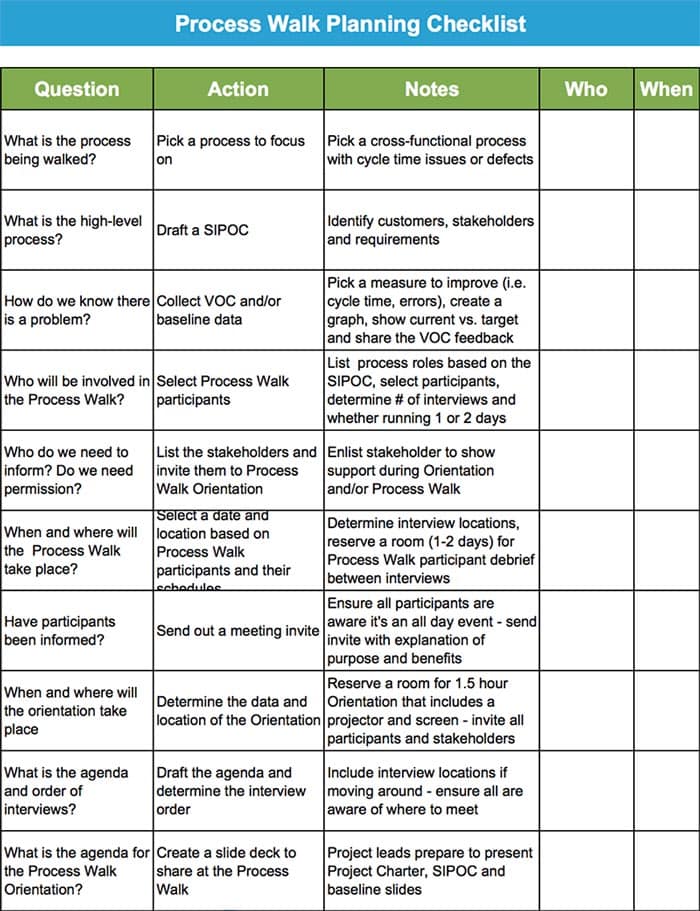What is Gemba walks? In the world of continuous improvement and lean management, the term "Gemba Walk" often comes up. But what is a Gemba walk and why is it important in the business world? If you've ever been curious about the concept, you're about to embark on a journey to discover the power of Gemba walks. Let's explore what is gemba walks, why they're a critical tool, and how to do them to achieve operational excellence.
Table Of Contents
- What Is Gemba Walks? And Why Is It Important?
- 3 Elements Of Effective Gemba Walks
- How To Do Gemba Walks
- 1. Define the Purpose and Objectives
- 2. Prepare for the Walk
- 3. Choose the Timing
- 4. Assemble a Team
- 5. Define Roles and Responsibilities
- 6. Prioritize Safety
- 7. Prepare Observations and Questions
- 8. Promote Open Communication
- 9. Actively Observe and Engage
- 10. Assess Safety and Compliance
- 11. Identify Opportunities for Improvement
- 12. Document Findings and Implement Actions
- What Is A Gemba Walk Checklist
- Key Takeaways
- FAQs What Is Gemba Walks
What Is Gemba Walks? And Why Is It Important?
What is Gemba Walks? Gemba Walk is a management practice where leaders or managers go to the place where employees work, called the "gemba." The purpose of this practice is to observe, engage, and learn from employees. This term originates from Japanese manufacturing practices, particularly the Toyota Production System, where "Gemba" means the actual place where value is created in a production process.

But what makes Gemba Walks so important? Let's delve into their significance:
- Real-Time Understanding: Gemba Walks allow leaders to gain a real-time, firsthand understanding of how processes and operations occur. By being physically present on the shop floor, in the office, or wherever the work happens, they can directly see the challenges, bottlenecks, and opportunities for improvement.
- Employee Engagement: When leaders conduct Gemba Walks, it sends a powerful message to employees. It shows that their work is valued, and their insights matter. This engagement can lead to a more collaborative work environment where employees feel heard and are more likely to share their ideas for improvement.
- Data-Driven Decision Making: Gemba Walks provide data and observations that can inform data-driven decision-making. This, in turn, can lead to strategic improvements and more informed choices.
- Cultural Change: Implementing regular Gemba Walks can transform an organization's culture. It shifts the focus from "managing from the desk" to "managing by walking around." This cultural change often leads to a more agile, responsive, and improvement-oriented organization.
3 Elements Of Effective Gemba Walks
An effective Gemba Walk comprises three essential elements:
1/ Purpose and Objectives:
- What is the main purpose of Gemba walk? Clarity in defining the purpose and objectives is fundamental. It guides the walk, helping you focus on specific goals, such as process improvement or gathering employee feedback.
- Objectives should align with the organization's broader priorities, ensuring the walk contributes to overarching goals.
2/ Active Observation and Engagement:
An effective Gemba Walk involves active observation and meaningful engagement. This isn't a passive stroll but an immersive experience.
3/ Follow-Up and Action:
The Gemba Walk doesn't end when you leave the Gemba. Follow-up and action are vital for translating insights into tangible improvements.
How To Do Gemba Walks
Conducting effective Gemba Walks involves a structured process that includes multiple steps to ensure that the walk is purposeful and productive. Here are 12 steps to guide you through the Gemba Walk process:

1. Define the Purpose and Objectives:
Clearly state the reason for the Gemba Walk and the specific objectives you want to achieve. Are you focused on process improvement, problem-solving, or employee engagement? Knowing the purpose sets the direction for the entire walk.
2. Prepare for the Walk:
Familiarize yourself with relevant data, reports, and information related to the area you'll be visiting. This background knowledge helps you understand the context and potential areas of concern.
3. Choose the Timing:
Select an appropriate time to conduct the walk, ideally during regular work hours or relevant shifts. This timing ensures that you observe typical working conditions.
4. Assemble a Team (if applicable):
Depending on the complexity of the area, consider forming a team to accompany you. Team members may provide additional expertise and perspectives.
5. Define Roles and Responsibilities:
Assign specific roles and responsibilities to team members. Roles might include an observer, questioner, and note-taker, ensuring that each team member contributes to the walk's success.
6. Prioritize Safety:
Ensure that safety is a top priority. Verify that safety gear and personal protective equipment are available and used, especially in environments where safety is a concern.
7. Prepare Observations and Questions:
Create a list of items, processes, or areas you want to observe during the walk. Additionally, prepare open-ended questions to ask employees and process owners.

8. Promote Open Communication:
Communicate with employees that the Gemba Walk is an opportunity to learn and gather insights. Encourage open and two-way communication, emphasizing the importance of their input.
9. Actively Observe and Engage:
During the walk, actively observe work processes, equipment, workflow, and the work environment. Take notes and use a camera or mobile device to document what you see.
Engage with employees by asking questions related to their tasks, challenges, and potential improvements. Listen attentively to their responses.
10. Assess Safety and Compliance:
Pay special attention to safety and compliance issues. Ensure that employees are following safety regulations and standards and that quality standards and procedures are being adhered to.
11. Identify Opportunities for Improvement:
Look for sources of waste and opportunities to improve efficiency. These may include overproduction, defects, waiting times, and excess inventory.
12. Document Findings and Implement Actions:
After the walk, document your observations and findings. Identify specific actions that need to be taken based on the insights gained. Assign responsibilities, set deadlines for implementation, and establish a feedback loop for ongoing improvement.
What Is A Gemba Walk Checklist
Here are some of gemba walk examples questions that can be used as a checklist during your walk:
- How would you describe the current work process?
- Are safety protocols being followed effectively?
- Are visual management tools in use and effective?
- Can you identify sources of waste or bottlenecks?
- Are employees engaged in their tasks?
- Is the work environment conducive to efficiency?
- Are there common quality issues or defects?
- Are tools and equipment well-maintained?
- Have employees provided feedback or suggestions?
- Is standard work documented and followed?
- How do employees understand customer needs?
- What improvements can be implemented?

Key Takeaways
What is Gemba walks? Gemba Walks is a dynamic and essential approach to improving operational efficiency and fostering a culture of continuous improvement within organizations.
Following Gemba walks, don’t forget to use AhaSlides. AhaSlides provides interactive features more effective meetings, brainstorming sessions, and collaborative discussions, making it an ideal companion for implementing the findings and ideas gathered during Gemba Walks.
FAQs About What Is Gemba Walks
What does Gemba walk stand for?
Gemba Walk stands for "Going to the actual place." It's a management practice where leaders visit the workplace to observe and engage with employees.
What are the three elements of the Gemba Walk?
The three elements of the Gemba Walk are: Purpose and Objectives, Active Observation and Engagement, and Follow-Up and Action.
What is a Gemba walk checklist?
A Gemba Walk checklist is a structured list of items and questions used during the walk to ensure a systematic approach to observing and gathering insights from the workplace.
Ref: KaiNexus | Safety Culture | Six Sigma DSI








